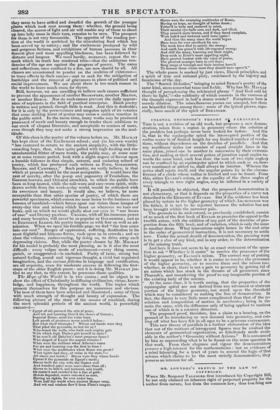COLONEL THOMPSON'S THEORY Oi PARALLELS.
THIS is not a revision of an old work, but proposes a new demon- stration, taken from a region in geometry where the solution of
the problem has perhaps never been looked for before. And this is, that in the equiangular spiral the intercepted portion of the radius vector is of limited length for any limited number of revolu- tions, without dependence on the doctrine of parallels. And that
any rectilinear series (or number of equal straight lines in the same plane, joined one to another in succession by their extremi- ties, and makina' at their several points of junction equal angles to- wards the same hand, each less than the sum of' two right angles) can be confined by an equiangular spiral to which such se es, how- ever continued or added to, shall always be interior. Whence the series shall rejoin itself, and the angular points lie in the circum- ference of a circle whose radius is limited and can be found. From this, either Euemis axiom, or the equality of the three angles of every triangle to two right angles, may be inferred in a variety of ways. It will possibly be objected, that the proposed demonstration is not elementary, or that it depends on the properties of a curve not described in the Elements of EUCLID. But if the evidence has been placed by nature in the higher geometry of which Aldan snss was the father, it is not to be rejected because the solution has not been brought within the narrower pale. The grounds to be understood, as previously established, consist of so much of the first book of EUCLID as precedes the appeal to the twelfth axiom, with the addition of any part of the doctrine of pro- portion from the fifth book, and of variation, which is only the same in another dress. What innovations might hence in the end arise in the order of geometrical instruction, it is not necessary to settle now. Under the actual dearth of demonstration, the pressing want is to get a clue of any kind, and in any order, to the determined= of the missing truth. And here it does not seem to be an exact statement of' the ques- tion to ask " Whether is it easier" to receive the processes of the higher geometry, or EUCLID'S axiom. The correct way of putting it would appear to be, whether it is easier to receive the processes of the higher geometry, or to receive them and the axiom too; whether, in short, there is not a gain to geometry by getting rid of an axiom which has stuck in the throats of all geometers since Pharaoh's, and transferring, the proof to any imaginable portion of the existing body of the science. At the same time, it is worth noting, that the properties of the equiangular spiral are not derived from any advanced or abstruse portion of the higher geometry, but stand upon the threshold which may be considered as making the line of demarcation. In fact, the theory is very little more complicated than that of the re- solution and composition of motion in mechanics ; being in the main the same, with the difference only of being applied to motions one of which is in a rotatory direction.
The proposed proof; therefore, has a claim to a hearing, on the ground of its introducing no new demand into geometry, and cut- ting off what has been fat in all ages to be a grievous excrescence.
This new theory of parallels is a further elaboration of the idea that out of the motions of introgyrant figures may be evolved the elements of geometrical organization, so felicitously made avail- able in the author's " Geometry without Axioms." It is announced by him as superseding what is to be found on the same question in that work. From their elegance and vigour the demonstrations possess a high interest for the mathematician : but as evidence of a mind labouring for a tract of years to amend the logic of that science which claims to be the most strictly demonstrative, they possess an interest for all.


























 Previous page
Previous page